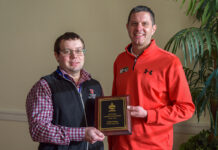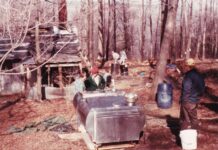By Katie Pratt
LEXINGTON, Ky. – Apple trees are popular additions to home landscapes because of their fruit production.
However, many home gardeners are not prepared for the onslaught of diseases that bombard the trees every year. To minimize risk of disease and reduce reliance on preventative fungicide applications, home gardeners may consider selecting disease resistant cultivars, said Nicole Ward Gauthier, extension plant pathologist with the University of Kentucky College of Agriculture, Food and Environment.
“Although backyards do not have the immense disease pressure experienced in commercial orchards, a proactive disease-control program is still essential,” Gauthier said. “Apple production requires a dedicated gardener and often a preventative spray schedule, which could include 10 or more fungicide applications throughout the growing season. Without some type of preventative program, disease loss will be extremely high.”
Blight, scab, rush and mildew
Some of the most destructive diseases affecting apples include fire blight, apple scab, cedar apple rust and powdery mildew. Fire blight and cedar apple rust are the most prevalent. Fire blight causes twig and branch dieback, which can result in death of the entire tree within two to three years. Cedar apple rust causes leaf drop and fruit infections. Infected fruit inedible, and leaf drop for three years in a row may stress a tree to the point of death.
“It is safe to say that nearly every homeowner will see some damage from those two diseases on a regular basis,” Gauthier said. “In years with warm, rainy springs, trees can become severely damaged.”
Selection of disease-resistant apple cultivars will provide some disease resistance in Kentucky and reduce numbers of required fungicide applications. Gauthier recommends Enterprise, Liberty, Priscilla and Winecrisp. A full list of disease-resistant recommendations for Kentucky is available on Gauthier’s blog, in the UK plant pathology fact sheet titled Simplified Backyard Apple Spray Guides at and in the Midwest Home Fruit Production Guide.
While many of the recommended cultivars are disease resistant, they have little resistance to insects.
Home gardeners wanting to minimize insecticide applications may want to bag individual fruit when they are roughly an inch in diameter. Ric Bessin, UK extension entomologist, authored a fact sheet on how to bag fruit. ENTFACT 218: Bagging Apples: Alternative Pest Management for Hobbyists is available online.
Information also is available in UK extension publication ID-21: Disease and Insect Control for Homegrown Fruit in Kentucky, Including Organic Alternatives.











